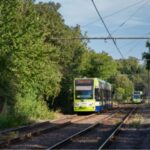Transport for London (TfL) has published a new Green Infrastructure and Biodiversity Plan, as part of its continuing work to become the strong, green heartbeat for London.
The plan, which fully aligns with TfL’s Corporate Environment Plan, published in 2021, sets out how TfL will improve and care for green infrastructure and biodiversity across its estate and networks. It captures in one place, for the first time, its existing relevant targets, legal requirements and policy commitments, while also setting out the strategic actions TfL will take to deliver them. The plan was developed following a wide range of engagement within and outside TfL, including London’s boroughs.
This new plan will ensure TfL meets a range of commitments to further enhance and support green infrastructure and biodiversity across London, including:
Achieving a 10 per cent biodiversity net gain on applicable schemes (i.e. planning system projects and Nationally Significant Infrastructure Projects) from February 2024
Delivering a net gain in biodiversity across TfL’s estate by 2030, compared to the 2018 biodiversity baseline map
Boosting tree canopy cover across TfL by 10 per cent by 2050, compared with the 2016 baseline
Doubling wildflower verges to 260,000 square metres in 2024, and developing a longer-term plan to continue their introduction across London
Ensuring 5,000 square metres of Sustainable Drainage Systems (SuDS), such as rain gardens, are installed on TfL’s road network each year
Further reduce the use of pesticides across TfL and eliminate where operationally and financially feasible
As one of London’s largest landowners, with more than 2,300 hectares across the capital, almost a third of TfL’s land is covered by vegetation. This includes land which intersects two Special Areas of Conservation, six Sites of Special Scientific Interest, eight Local Nature Reserves and 139 Sites of Importance for Nature Conservation. TfL’s wide variety of habitats, from woodland to wetland, support more than 1,000 animal species – such as a range of butterfly species and eight different species of bat within a disused railway tunnel at Highgate – as well as almost 700 plant species across London. Many of the species found on or near TfL’s estate are legally protected and therefore it is important to protect their habitat.
In 2022, TfL was the first transport provider in the UK to carry out a natural capital account for its estate, to the high standards of the Natural Capital Protocol and the relevant British Standard. The account found that the benefits from TfL’s natural capital assets that can be monetised have a current estimated gross asset value of £328m. While this is a significant figure, it is still likely to be an underestimate, and TfL is now planning on a range of biodiversity research and innovation projects to help fill in data gaps and improve future accounts.
Using this information, TfL will be able to make better decisions about how to manage its green infrastructure and increase biodiversity. TfL plans to double the area of wildflower verges alongside the TfL Road Network to 260,000 square metres in 2024. It will also explore potential ways to further increase biodiversity at these sites, which already support 17 different species of butterfly, five of which are London Priority species. TfL is also on track to meet its commitment to deliver an additional 5,000 square metres of Sustainable Drainage Systems (SuDS), such as rain gardens, on its road network each year. These nature-based solutions not only help support biodiversity but also help reduce the risk of flooding from storms.
Across London, TfL says it is also meeting its target to increase the overall number of street trees on its estate by one per cent per year between 2016 and 2025. A plan to help strategically increase tree canopy across TfL’s estate by 10 per cent by 2050 will be published by March 2025. Tree canopies provide shelter from the sun as well as habitats for birds and wildlife.
The health of soil across London can affect its capacity to hold or drain water, and its ability to support particular habitats. The plan outlines how soil on TfL land will be protected from degradation or contamination, reducing the need for additional resources, such as fertiliser and compost. TfL also plans to eliminate the use of pesticides where operationally and financially feasible, having already reduced highways glyphosate use by 70 per cent in recent years.
TfL plays a key role in not only helping to protect, connect and enhance green and canopy cover across its own estate, but also in assisting in making other green spaces, such as parks and recreation grounds, accessible to the public. Providing sustainable travel access can help reduce social and environmental inequalities, so to inform this work, TfL will be mapping sustainable travel access to London’s green spaces in relation to socio-economic factors by the end of 2025. This will help inform future investment decisions and ensure that those walking, cycling or taking public transport have clear and easy access to green spaces across the city.
Lilli Matson, Chief Safety, Health and Environment Officer at Transport for London said: “As one of London’s largest landowners, TfL has an extensive network of green corridors, from tree-lined streets to trackside woodland. Together, these play a crucial role in connecting London’s green spaces for wildlife.
“Our new Green Infrastructure and Biodiversity plan forms part of our continuing work in creating a greener, more biodiverse city that is resilient and well adapted to climate change. By lowering the environmental impact of our business and offering a range of sustainable ways to travel across London, we can use our real estate and infrastructure to create a city that allows people and wildlife to flourish.”
Steve Bolton, Big City Butterflies Project Officer at Butterfly Conservation, said: “Butterfly Conservation welcomes TfL’s commitment to restoring biodiversity and enhancing green infrastructure. We have supported the expansion of the wildflower verges trail engaging local volunteers in butterfly recording and advising on planting schemes to support butterflies and moths. Improving biodiversity data, habitat quality and connectivity will help support the recovery of butterflies and moths so they can thrive in the urban environment and be enjoyed by everyone.”
Becky Garden, Partnership Officer at Greenspace Information for Greater London (GiGL), said: “GiGL’s contribution to TfL’s Green Infrastructure and Biodiversity Plan, through their provision of robust environmental data, visualisations, and modelling, has allowed for an informed approach towards improving and protecting the environment. By providing comprehensive data insights into biodiversity and London’s outdoor spaces, GiGL has enabled TfL to foster a plan that will benefit the well-being of people and nature alike. The collaborative efforts between TfL and GiGL facilitates the flow of data across London, from the collection, to use in informing decisions, as it has for the many years TfL has been partnered with GiGL.”
The publication of TfL’s Green Infrastructure and Biodiversity Plan is just part of TfL’s wider work to drive sustainability across London and become the strong green heartbeat of London. TfL is investing in further decarbonising its operations, including transitioning its support vehicles and buses. It remains on track to have a fully zero-emission bus fleet by 2034, and with Government funding, this could be accelerated to 2030, which would catapult the potential for new production models and help transform the bus industry in the UK.
TfL is working to remove fossil fuels across its building estate, as well as developing wider projects to improve energy efficiency and identify opportunities to generate renewable energy across its estate. Work to procure Power Purchase Agreements as part of its wider ambition to use 100 per cent renewable source electricity across TfL’s operations by 2030 is ongoing.
Across London, TfL is also converting lighting within stations, bus shelters and on trains to LED lighting, which uses up to 60 per cent less energy than traditional lighting while providing around 10 per cent brighter light. Currently, more than a third of Tube stations across London have been converted to LED lighting, and TfL expects to have all bus shelters, including those used in advertising panels, converted to LED lighting shortly.
For more information, please visit www.tfl.gov.uk/biodiversity

